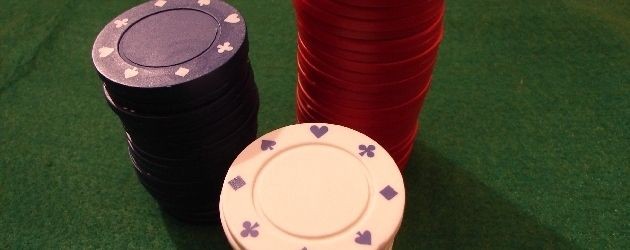Recommended Poker Room
As we have seen in the article “Introduction to ICM (Independent Chip Model)”, you do not have to do ICM calculations by yourself. You can use one of the free tools to do the math. A website offering a free web-based ICM calculator is holdemresources.net.
If you are an advanced Sit and Go (SNG or STT) player, you might want to know how ICM exactly works. While it is not necessary to do any of the calculations by yourself, it is valuable to at least know how the calculations are performed. Remember: With ICM, we can convert the value of chips in a poker tournament into real dollars.
Independent Chip Model: Example of an ICM calculation
Let’s make a sample ICM computation for the following situation: in a full ring SNG, 3 players are left (the bubble boy has just busted out of the tournament):
SB: 3000 chips (20% of all chips): Small Stack
BB: 4500 chips (30% of all chips): Medium Stack
BTN: 7500 chips (50% of all chops): Big Stack
Total chips: 15000, payout: 50%, 30%, 20%, total prize pool: $100
What we will do now is calculate the probability for each of the players to rank first, second and third. In a second step, we will multiply the probabilities for each position with the prize money for each position and sum them up. This will give us the “equity”, the amount of the prize pool each player’s chips are worth. As you might recall, the more chips you have, the less each additional chip is worth. So while the BTN has 50% of all chips, he has less than 50% equity: 50% equity would mean that he gets first in every game he plays, winning 50% of the prize pool. But even though he is in the best position to become first, he won’t win each game. And of course the small stack (SB) with 20% of all chips will sometimes get lucky and become second or even win the tournament. Therefore, his 20% of all chips must be worth more than 20% of the prize pool ($20).
So let’s look at the possibilities for the rankings in this tournament with three players left:
1st option: 1. BTN, 2. SB, 3. BB
2nd option: 1. BTN, 2. BB, 3. SB
3rd option: 1. SB, 2. BTN, 3. BB
4th option: 1. SB, 2. BB, 3. BTN
5th option: 1. BB, 2. BTN, 3. SB
6th option: 1. BB, 2. SB, 3. BTN
As we can see, there are only 6 possible rankings.
Probability for the BTN to win
As the BTN has 50% of the chips, he is getting first 50% of the time (7500/15000). The SB with 20% of the chips is getting first 20% of the time (3000/15000). And the BB with 30% of the chips will win the SnG 30% of the time (4500/15000).
Let’s go into more detail and do the whole calculation for the player sitting in the BTN. He wins 50% of all games. But how often will he get second and third? If we want to know how often he will score second, we have to examine the options 3 and 5 from above.
Probability for the BTN to rank second
Option 3: SB has a 20% chance to become first. In that case either the BTN (with 7500 chips) or the BB (with 4500 chips) can become second. The probability that the BTN will become second, is 7500 / (7500 + 4500) = 62.5%. The probability, that the BTN will become second if the SB wins the tourney is 20% x 62.5% = 12.5%
Option 5: Analog to the calculation above, the probability that the BB wins the tourney and the BTN is second, is 21.4% (30% x (7500/10500).
If we add the probabilities from option 3 and 5 we get the total probability that the big stack will score second, which is 33.9% (12.5% + 21.4%).
Probability for the BTN to rank third
Option 4: the probability for the BTN to become third is 20% x (4500/12000) = 7.5%.
Option 6: the probability for the BTN to become third is 30% x (3000/10500) = 8.6%
If you add the two probabilities, you end up with a chance of 16.1% (7.5% + 8.6%) for the BTN to end the SNG on place three.
ICM Calculation: From Chips to Dollar EV
According to the calculatons from above, the BTN with his stack of 7500 chips has the following probabilities to end the Sit and Go:
First place: 50% ($50 prize money)
Second place: 33.9% ($30 prize money)
Third place: 16.1% ($20 prize money)
If we multiply the probabilities with the prize money, we get the expected value for the 7500 chips of the BTN: 50% x $50 + 33.9% x $30 + 16.1% x $20 = $38.39.
If we make the calculations for the SB and the BB, we get the following $EV:
SB: 28.86$
BB: 32.75$
The sum of the three figures is $100, the prize pool.
This example shows clearly, that the additional chips in a SnG are less valuable than the chips that you already have. The BTN has 2.5 times more chips than the SB (7500 vs. 3000), but his $EV is only 1.33 times larger ($38.39/$28.86). This might sound counter-intuitive to you. But think about it: Every player will get $20 (third place) for sure. The players only play for an additional $10 (for second place) and $30 (for first place).
Summary Sample ICM Calculation
As you have seen, the conversion from chips into real dollars (from cEV to $EV) with the Independent Chip Model (ICM) is not very simple and is very time consuming. You will not be able to compute such ICM calculations in real-time while playing poker. However, as an advanced SNG tournament player, you should at least have a basic understanding of how an ICM calculation works. You can always plug the results from pages like holdemresources.net.
And remember the implications of ICM for bubble situations in SNGs: additional chips are worth less than the chips you already have. So use this knowledge to your advantage.


 www.
www.
Thank you for your article.
I don’t find how you calculate that:
SB: 28.86$
BB: 32.75$
Hi Pokerman
The whole calculations above are for the BTN. You see, that’s a lenghty process. If you understand it, you can do the calculation for SB and BB analogous to BTN. Or just use an ICM calculator.